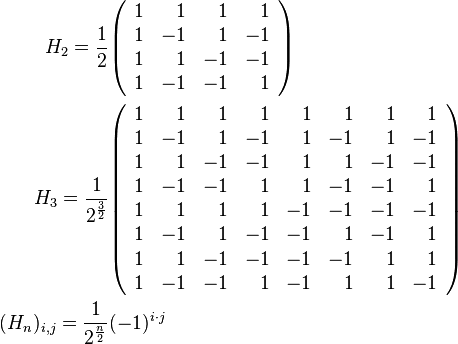Hadamard transform
.svg.png)
(1,0,1,0,0,1,1,0) * H(8) = (4,2,0,−2,0,2,0,2)
.svg.png)
This is a faster way to calculate the Walsh spectrum of (1,0,1,0,0,1,1,0).
.svg.png)
The Hadamard transform (also known as the Walsh–Hadamard transform, Hadamard–Rademacher–Walsh transform, Walsh transform, or Walsh–Fourier transform) is an example of a generalized class of Fourier transforms. It performs an orthogonal, symmetric, involutional, linear operation on  real numbers (or complex numbers, although the Hadamard matrices themselves are purely real).
real numbers (or complex numbers, although the Hadamard matrices themselves are purely real).
The Hadamard transform can be regarded as being built out of size-2 discrete Fourier transforms (DFTs), and is in fact equivalent to a multidimensional DFT of size  .[2] It decomposes an arbitrary input vector into a superposition of Walsh functions.
.[2] It decomposes an arbitrary input vector into a superposition of Walsh functions.
The transform is named for the French mathematician Jacques Hadamard, the German-American mathematician Hans Rademacher, and the American mathematician Joseph L. Walsh.
Definition
The Hadamard transform Hm is a 2m × 2m matrix, the Hadamard matrix (scaled by a normalization factor), that transforms 2m real numbers xn into 2m real numbers Xk. The Hadamard transform can be defined in two ways: recursively, or by using the binary (base-2) representation of the indices n and k.
Recursively, we define the 1 × 1 Hadamard transform H0 by the identity H0 = 1, and then define Hm for m > 0 by:
where the 1/√2 is a normalization that is sometimes omitted. Thus, other than this normalization factor, the Hadamard matrices are made up entirely of 1 and −1.
Equivalently, we can define the Hadamard matrix by its (k, n)-th entry by writing
and
where the kj and nj are the binary digits (0 or 1) of k and n, respectively. Note that for the element in the top left corner, we define:  . In this case, we have:
. In this case, we have:
This is exactly the multidimensional  DFT, normalized to be unitary, if the inputs and outputs are regarded as multidimensional arrays indexed by the nj and kj, respectively.
DFT, normalized to be unitary, if the inputs and outputs are regarded as multidimensional arrays indexed by the nj and kj, respectively.
Some examples of the Hadamard matrices follow.
(This H1 is precisely the size-2 DFT. It can also be regarded as the Fourier transform on the two-element additive group of Z/(2).)
where  is the bitwise dot product of the binary representations of the numbers i and j. For example, if
is the bitwise dot product of the binary representations of the numbers i and j. For example, if  , then
, then  , agreeing with the above (ignoring the overall constant). Note that the first row, first column of the matrix is denoted by
, agreeing with the above (ignoring the overall constant). Note that the first row, first column of the matrix is denoted by  .
.
The rows of the Hadamard matrices are the Walsh functions.
Quantum computing applications
In quantum information processing the Hadamard transformation, more often called Hadamard gate in this context (cf. quantum gate), is a one-qubit rotation, mapping the qubit-basis states  and
and  to two superposition states with equal weight of the computational basis states
to two superposition states with equal weight of the computational basis states  and
and  . Usually the phases are chosen so that we have
. Usually the phases are chosen so that we have
in Dirac notation. This corresponds to the transformation matrix
in the  basis.
basis.
Many quantum algorithms use the Hadamard transform as an initial step, since it maps n qubits initialized with  to a superposition of all 2n orthogonal states in the
to a superposition of all 2n orthogonal states in the  basis with equal weight.
basis with equal weight.
Hadamard gate operations
One application of the Hadamard gate to either a 0 or 1 qubit will produce a quantum state that, if observed, will be a 0 or 1 with equal probability (as seen in the first two operations). This is exactly like flipping a fair coin in the standard probabilistic model of computation. However, if the Hadamard gate is applied twice in succession (as is effectively being done in the last two operations), then the final state is always the same as the initial state. This would be like taking a fair coin that is showing heads, flipping it twice, and it always landing on heads after the second flip.
Computational complexity
The Hadamard transform can be computed in n log n operations (n = 2m), using the fast Hadamard transform algorithm.
Other applications
The Hadamard transform is also used in data encryption, as well as many signal processing and data compression algorithms, such as JPEG XR and MPEG-4 AVC. In video compression applications, it is usually used in the form of the sum of absolute transformed differences. It is also a crucial part of Grover's algorithm and Shor's algorithm in quantum computing.
See also
- Fast Walsh-Hadamard transform
- Pseudo-Hadamard transform
- Haar transform
- Generalized Distributive Law
External links
- Ritter, Terry (August 1996). "Walsh-Hadamard Transforms: A Literature Survey".
- Akansu, A.N.; Poluri, R. (July 2007). "Walsh-Like Nonlinear Phase Orthogonal Codes for Direct Sequence CDMA Communications" (PDF). IEEE Trans. on Signal Processing 55 (7): 3800–6. doi:10.1109/TSP.2007.894229.
- Pan, Jeng-shyang Data Encryption Method Using Discrete Fractional Hadamard Transformation (May 28, 2009)
- Beddard, Godfrey (January 2011). "Pump-probe Spectroscopy using Hadamard Transforms" (PDF).
References
- ↑ Compare Figure 1 in Townsend, W. J.; Thornton, M. A. Walsh Spectrum Computations Using Cayley Graphs. CiteSeerX: 10.1.1.74.8029.
- ↑ Kunz, H.O. (1979). "On the Equivalence Between One-Dimensional Discrete Walsh-Hadamard and Multidimensional Discrete Fourier Transforms". IEEE Transactions on Computers 28 (3): 267–8. doi:10.1109/TC.1979.1675334.











